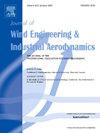在超高速列车相遇的场景中,通过基于鼻子的吸气和吹气来减少不利的隧道空气动力学
IF 4.9
2区 工程技术
Q1 ENGINEERING, CIVIL
Journal of Wind Engineering and Industrial Aerodynamics
Pub Date : 2025-08-20
DOI:10.1016/j.jweia.2025.106209
引用次数: 0
摘要
随着高速铁路的发展和超高速磁悬浮列车的出现,传统的被动缓解策略在解决隧道气动挑战方面越来越显不足。本研究采用主动气流控制(AFC),通过集成在车头的吸气和吹气槽,数值研究了两列火车在600 km/h的隧道中相互通过时的空气动力学响应。采用经过验证的三维可压缩URANS框架和滑动网格技术进行了仿真。分析了等体积流量下低速大面积(LVLA)和高速小面积(HVSA)两种狭缝构型以及吸吹速度(SBv)的影响。结果表明,与HVSA设计相比,LVLA设计性能更好,隧道壁压力峰值降低3.4%,阻力降低2.4%,滚动力矩降低6.7%。随着sv从0 ~ 45 m/s增加,隧道和列车表面压力波动均减小,并呈二次衰减趋势。峰间压力ΔP和微压力波(mpw)分别降低了27.2%和26.8%。此外,AFC还改善了所有车型的空气动力负载性能,横向力(ΔFy)比领先车型减少了31.5%,后吹气使后车正升力降低了22.8%,从而提高了隧道的运行稳定性。这些发现突出表明,AFC为缓解超高速铁路/磁悬浮系统中的隧道空气动力学问题提供了一种灵活有效的策略。本文章由计算机程序翻译,如有差异,请以英文原文为准。
Reducing adverse tunnel aerodynamics via nose-based suction & blowing during ultra-high-speed trains meeting scenario
With the advancement of high-speed railway and the advent of ultra-high-speed maglev, conventional passive mitigation strategies are increasingly insufficient in addressing the tunnel aerodynamic challenges. This study numerically investigates the aerodynamic responses of two trains passing each other in a tunnel at 600 km/h, employing active flow control (AFC) via suction and blowing slots integrated into the train noses. Simulations were conducted using a validated 3D compressible URANS framework with sliding mesh techniques. The analysis explores the effects of two slot configurations, low-velocity large-area (LVLA) and high-velocity small-area (HVSA), under constant volumetric flow rate, along with the influence of suction/blowing velocities (SBv). Results show that LVLA performs better, reducing tunnel wall pressure peaks by 3.4 %, drag by 2.4 %, and rolling moment by 6.7 % compared to HVSA design. As SBv increases from 0 to 45 m/s, both tunnel and train surface pressure fluctuations are reduced, following a quadratic decay trend. Notably, the peak-to-peak pressure ΔP and micro-pressure waves (MPWs) are reduced by 27.2 % and 26.8 %, respectively. Moreover, AFC also improves aerodynamic load performance across all cars, with lateral force (ΔFy) reduced by up to 31.5 % of the leading car, and rear-nose blowing lowering rear-car positive lift by 22.8 %, thereby enhancing tunnel operational stability. These findings highlight that AFC offers a flexible and effective strategy for alleviating tunnel aerodynamic issues in ultra-high-speed rail/maglev systems.
求助全文
通过发布文献求助,成功后即可免费获取论文全文。
去求助
来源期刊
CiteScore
8.90
自引率
22.90%
发文量
306
审稿时长
4.4 months
期刊介绍:
The objective of the journal is to provide a means for the publication and interchange of information, on an international basis, on all those aspects of wind engineering that are included in the activities of the International Association for Wind Engineering http://www.iawe.org/. These are: social and economic impact of wind effects; wind characteristics and structure, local wind environments, wind loads and structural response, diffusion, pollutant dispersion and matter transport, wind effects on building heat loss and ventilation, wind effects on transport systems, aerodynamic aspects of wind energy generation, and codification of wind effects.
Papers on these subjects describing full-scale measurements, wind-tunnel simulation studies, computational or theoretical methods are published, as well as papers dealing with the development of techniques and apparatus for wind engineering experiments.

 求助内容:
求助内容: 应助结果提醒方式:
应助结果提醒方式:


